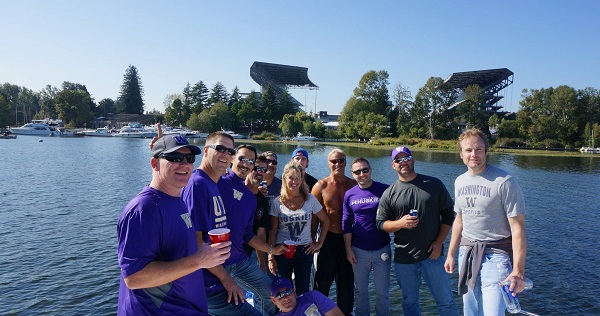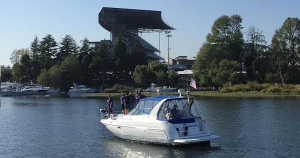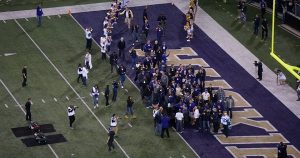
The deep monotone bellow resounds through the nooks and crannies of the vessel and off the surface of the sparkling turquoise water, along with a munificence of brilliant late Summer sunshine.
“Alright, we will park until four- thirty and then we will take the shuttle onto the shore and head to the Zone,” directs Captain Steve to the thirteen-person crew aboard his aptly named “Survivors” mini-yacht.
It is three hours before the University of Washington plays its most crucial football game in a decade and a half against the number seven ranked Stanford Cardinal, and the 40- foot boat floats in the milfoil infested 72 degree shallows of Union Bay roughly 300 yards offshore. The mood and intensity of the upcoming match-up is tempered by the peaceful and gentle lapping waves of Lake Washington and the stunning visual and panoramic backdrops of the Cascade Mountains, the buildings of the Seattle area and of course the cavernous and empty Husky stadium, soon to be filled with 70,000 rabid and cheering fans. Within proximity to captain Steve’s vessel, 40 to 50 ships of various sizes are spread out throughout the diminutive bay, and carrying passengers and fans enjoying the gem of a Seattle day, a pre-game libation and the comradery of a shared and unique experience.

Phil from Florida rallies the group of the “Survivors” together at the boat’s stern. “I want to give a hearty thanks to Captain Steve for this little shindig and Go Dawgs!” the boisterous cheers and yells capture the attention of a crew on a nearby 150 foot plus behemoth and the joyful sentiment of a carefree Friday is echoed. One of the Florida guys has even temporarily lost his shirt and comments that life is great without the daunting humidity of the South.
Captain Steve, did not always hold the unofficial-official title as a member of Seattle’s vibrant boating community and earned two letters for the University in the mid-1980’s as the “wedge buster” on special teams and sometimes defensive back which culminated with an Orange Bowl ring. His journey to Seattle is as fascinating as improbable and spanned three continents, all before he was 13 years of age. As a player, Steve Holzgraf specialized in facilitating effective and bone crushing kick-off coverage, and as an alum Captain Steve makes the annual floating pilgrimage or Sailgating to Montlake once or twice per football season. Real life however, transcends the game played within the familiar confines of the gridiron.
Born into a truly global family, Holzgraf spent the first three years of his life in Abidjan, Ivory Coast (Cote D’ivoire), as the citizens of the country adjusted to a new life of independence. In 1966 his father, a civil engineer, was beckoned to the epicenter of the Vietnam conflict and Holzgraf endured his formative years in the chaotic and dangerous theater of battle in Saigon. “I got so used to explosions from bombs and the sound of machine guns that I would just continue playing,” he reflects. “We were evacuated 11 times so I grew up learning to face real fear.”
Along with the University of Tennessee, UW’s fan base can select the boating alternative as a viable travel option. The stadium location on Lake Washington makes transportation by watercraft not only possible, but a tradition which Seattleites have taken advantage of for over 90 years. Holzgraf has indulged in the experience for a decade, an extremely trying period in the annals of a program with a sustained and proven history of success. “For me it is simple. I love boating, I am a proud alum and I like to throw a good party,” Captain Steve receives a pat on the back from one of the Florida guys and is offered a beer or two, even though he prefers a vodka mix.
“My first introduction to football was listening to the Minnesota Vikings on armed forces radio as they were the only game in town,” he says now armed with a tall vodka. “I loved (quarterback) Fran Tarkenton and he was definitely my first man crush.”
In 1972 Holzgraf’s mother had reached a monumental threshold and fearing for the lives of her family decided to prepare for a permanent evacuation. “Mom was absolutely terrified of flying so the only way out was by land or by sea,” Holzgraf shakes his head. “We spent weeks in the bottom of a cargo ship with three other families.
Floating across the Atlantic in the tiny confines of the watercraft, the family ended up safely in San Juan, Puerto Rico. Upon arrival and after a brief stop at port, the Holzgraf’s were whisked to Rotterdam, Netherlands via an oil rig, before eventually settling in Paris for one year. “The mental health professionals and captain obvious could tell you tell how I developed a love for boats,” quips Holzgraf.
At around 4:30ish a shuttle boat is flagged down using an orange fluorescent flag and the group is settled into the skiff for the 5 minutes of travel time to the dock at the Crew House, adjacent to the stadium. The intensity is burgeoning as a solid mass of fans claim all areas of open space surrounding the venue. Brilliant sunlight still manages to filter down as the temperature has reached a comfortable plateau. The maritime atmosphere of the boating environment has been effectively replaced by a sea of fandom and the reality that a football game is yet to be played. At this point the group disperses for various destinations of culinary or social protocol and introspective thoughts and wisdom will be reserved for the return voyage.
After an arduous and lengthy journey, the Holzgraf family finally arrived in the United States in 1977. The family chose to settle in Tumwater, Washington to be near relatives. “Honestly, I knew nothing about the University of Washington and the only thing that I could connect the dots were that the Vikings wore purple uniforms also,” says Holzgraf.
From high above the lake’s surface in the cozy confines of the stadium, “Survivors” is clearly visible in the bay against the barren peaks of the Cascades to the East. Like a toy boat in the bathtub, she gracefully turns on the tether of the anchors and reflects the waning sunlight. The crowd settles into their seats and the pathway is marked to a fevered pitch coalescing with promising hope of a potential victory.
After a “do everything” stellar career at Tumwater High School, Holzgraf was recruited by both Washington State’s Jim Walden and legendary Husky general Don James. “Ultimately it came down to who would guarantee time at running back,” he states.

In the late Summer of 1983, Holzgraf arrived in Pullman full of hope and ready to make a name for himself on the gridiron. However, much like his childhood, things took an unbelievable twist. “There was this kid from British Columbia (Canada) by the name of Rueben Mayes who everyone was talking about as an up and coming player,” says Holgraf. “Before I knew it the coaches were asking me to make a position change, and I had a decision to make.”
After only 11 days as a member of the Washington State University football team, he decided to transfer, while Mayes eventually forged a legendary career for the Cougars and was ultimately drafted into the National Football League by the New Orleans Saints in the third round of the 1986 draft and earned the offensive rookie of the year award.
During the apex of Washington’s complete and ornately brilliant and ingrained dismantling of Stanford 44-6, in the segue between dusk and the vacuous depths of nighttime, the flotilla of vessels are illuminated as a precursor to the Holidays with shimmering lights of red, green of white. The glittering disco ball from within the cabin and the celebratory raucous consisting of yelling and singing are the only unique identifiers on the silhouette of the “Survivors” as one-by-one the crew manages to reassemble using the network of skiffs as the stadium empties into darkness.
Holzgraf eventually earned a spot on the deep and talented roster of the 1984 University of Washington football team as a defensive back and special teams role player. “During the early practices I would never back down against the veteran players,” he looks towards the stadium from the captain’s chair on the boat, the lights transforming the structure into a fiery gem. “I go by the phrase, ‘intense completion breeds temporary enemies, but cements friends for life’, I definitely made both that year.”

The exploits of Holzgraf and the 1985 Orange Bowl team was forever immortalized into the tapestry of UW athletic history as the entire team was inducted into the athletic hall of fame during the Oregon State game, October 22. Captain Steve planned the logistics for a Sailgating assault across Lake Washington and garnered even more treasured memories.
As “Survivors” pulls from the enormous gravity well of Union Bay and history, the boat’s population has swelled to a population of 25, including a UW assistant football coach. With the music blaring, drinks flowing and voices hoarse and arms sore from celebrating, the vessel has transformed into a solitary island of bliss and the return trip spanning the lake to Kirkland will no doubt create its own definition in and of time.
Fifteen minutes closer to port, the clear sky is full of stars and completes a masterful globe of lights as the boat cruises at impulse power. After a hearty rendition of “Louie, Louie” Captain Steve’s gaze gradually pans from the vortex of mirth and dancing across still waters to the backdrop of the city and he quietly utters, “any journey is possible on a boat”. On this particular evening, the words make perfect sense.